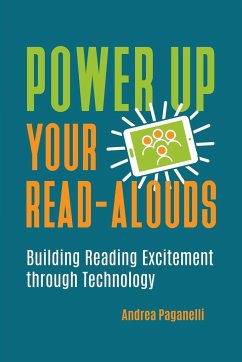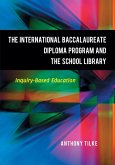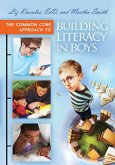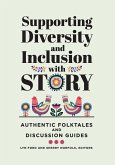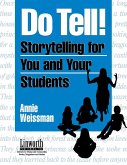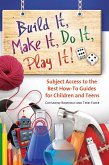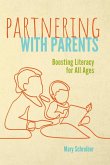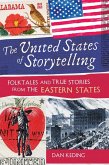- Broschiertes Buch
- Merkliste
- Auf die Merkliste
- Bewerten Bewerten
- Teilen
- Produkt teilen
- Produkterinnerung
- Produkterinnerung
Capture the hearts, minds, and attention of your digital-age listeners using read-aloud experiences that engage technology. â I wish my learners would be as excited about reading as they are about technologyâ is a lament frequently sung by those who seek to support reading development.
Andere Kunden interessierten sich auch für
![The International Baccalaureate Diploma Program and the School Library The International Baccalaureate Diploma Program and the School Library]() Anthony TilkeThe International Baccalaureate Diploma Program and the School Library47,99 €
Anthony TilkeThe International Baccalaureate Diploma Program and the School Library47,99 €![The Common Core Approach to Building Literacy in Boys The Common Core Approach to Building Literacy in Boys]() Liz KnowlesThe Common Core Approach to Building Literacy in Boys48,99 €
Liz KnowlesThe Common Core Approach to Building Literacy in Boys48,99 €![Supporting Diversity and Inclusion With Story Supporting Diversity and Inclusion With Story]() Supporting Diversity and Inclusion With Story47,99 €
Supporting Diversity and Inclusion With Story47,99 €![Do Tell! Do Tell!]() Annie WeissmanDo Tell!40,99 €
Annie WeissmanDo Tell!40,99 €![Build It, Make It, Do It, Play It! Subject Access to the Best How-To Guides for Children and Teens Build It, Make It, Do It, Play It! Subject Access to the Best How-To Guides for Children and Teens]() Catharine BomholdBuild It, Make It, Do It, Play It! Subject Access to the Best How-To Guides for Children and Teens78,99 €
Catharine BomholdBuild It, Make It, Do It, Play It! Subject Access to the Best How-To Guides for Children and Teens78,99 €![Partnering with Parents Partnering with Parents]() Mary SchreiberPartnering with Parents49,99 €
Mary SchreiberPartnering with Parents49,99 €![The United States of Storytelling The United States of Storytelling]() Dan KedingThe United States of Storytelling64,99 €
Dan KedingThe United States of Storytelling64,99 €-
-
-
Capture the hearts, minds, and attention of your digital-age listeners using read-aloud experiences that engage technology. â I wish my learners would be as excited about reading as they are about technologyâ is a lament frequently sung by those who seek to support reading development.
Produktdetails
- Produktdetails
- Verlag: Bloomsbury Publishing Plc
- Seitenzahl: 166
- Erscheinungstermin: 31. Juli 2019
- Englisch
- Abmessung: 234mm x 156mm x 9mm
- Gewicht: 264g
- ISBN-13: 9781440865206
- ISBN-10: 1440865205
- Artikelnr.: 54551644
- Herstellerkennzeichnung
- Libri GmbH
- Europaallee 1
- 36244 Bad Hersfeld
- gpsr@libri.de
- Verlag: Bloomsbury Publishing Plc
- Seitenzahl: 166
- Erscheinungstermin: 31. Juli 2019
- Englisch
- Abmessung: 234mm x 156mm x 9mm
- Gewicht: 264g
- ISBN-13: 9781440865206
- ISBN-10: 1440865205
- Artikelnr.: 54551644
- Herstellerkennzeichnung
- Libri GmbH
- Europaallee 1
- 36244 Bad Hersfeld
- gpsr@libri.de
Andrea Paganelli is an assistant professor at Western Kentucky University.
Acknowledgments
Introduction
Part One Digital Read-Aloud: Creating the Experience
Chapter 1Reading Aloud: A Brief History and the Issues and Importance of
Technology Inclusion
Reading Aloud: A Brief History
Reading Aloud Rocks the Ages!
Issues Related to Reading Aloud with Technology
The Importance of Technology Inclusion in Read-Aloud
Conclusion
Chapter 2Knowing Your Audience Is Key to Planning for Digital Read-Aloud
Using Technology-Infused Digital Read-Aloud to Augment Engagement
Digital Read-Aloud Can Be Used to Promote Lifelong Learning in Varied Ages
and Demographics
Digital Read-Aloud Can Be Used One-on-One, in Small Groups, or for Many
Digital Read-Aloud Can Be Cross-Curricular and Embrace Any Subject
Conclusion
Chapter 3Planning for a Digital Read-Aloud
Digital Resource Type Categories Available for Digital Read-Aloud
Transmedia Resource Selection Process for Digital Read-Aloud
Preparing to Present a Digital Read-Aloud
Planning for Cross-Curricular Digital Read-Aloud
Developing a Schedule for Cross-Curricular Digital Read-Aloud
Conclusion
Chapter 4Implementation of the Digital Read-Aloud
Manage the Technology in Your Environment during the Digital Read-Aloud
Managing the Participants during the Digital Read-Aloud
Delivery of the Digital Read-Aloud
Conclusion
Chapter 5Reflection on the Digital Read-Aloud
Examine the Digital Read-Aloud Experience and Methods of Improvement for
Participants
Examine the Digital Read-Aloud Experience and Methods of Improvement of
Delivery
Keep the Digital Read-Aloud Technology Experience Relevant through
Continual Evaluation
Conclusion
Part Two Examples of Digital Read-Aloud Experiences
Chapter 6Language Arts
Pre-K
Elementary School
Middle School
High School
Lifelong Learner
Conclusion
Chapter 7Math
Pre-K
Elementary School
Middle School
High School
Lifelong Learner
Conclusion
Chapter 8Science
Pre-K
Elementary School
Middle School
High School
Lifelong Learner
Conclusion
Chapter 9History/Social Studies
Pre-K
Elementary School
Middle School
High School
Lifelong Learner
Conclusion
Chapter 10Visual Performing Arts
Pre-K
Elementary School
Middle School
High School
Lifelong Learner
Conclusion
Conclusion
Glossary
Works Cited
Further Reading
Index
Introduction
Part One Digital Read-Aloud: Creating the Experience
Chapter 1Reading Aloud: A Brief History and the Issues and Importance of
Technology Inclusion
Reading Aloud: A Brief History
Reading Aloud Rocks the Ages!
Issues Related to Reading Aloud with Technology
The Importance of Technology Inclusion in Read-Aloud
Conclusion
Chapter 2Knowing Your Audience Is Key to Planning for Digital Read-Aloud
Using Technology-Infused Digital Read-Aloud to Augment Engagement
Digital Read-Aloud Can Be Used to Promote Lifelong Learning in Varied Ages
and Demographics
Digital Read-Aloud Can Be Used One-on-One, in Small Groups, or for Many
Digital Read-Aloud Can Be Cross-Curricular and Embrace Any Subject
Conclusion
Chapter 3Planning for a Digital Read-Aloud
Digital Resource Type Categories Available for Digital Read-Aloud
Transmedia Resource Selection Process for Digital Read-Aloud
Preparing to Present a Digital Read-Aloud
Planning for Cross-Curricular Digital Read-Aloud
Developing a Schedule for Cross-Curricular Digital Read-Aloud
Conclusion
Chapter 4Implementation of the Digital Read-Aloud
Manage the Technology in Your Environment during the Digital Read-Aloud
Managing the Participants during the Digital Read-Aloud
Delivery of the Digital Read-Aloud
Conclusion
Chapter 5Reflection on the Digital Read-Aloud
Examine the Digital Read-Aloud Experience and Methods of Improvement for
Participants
Examine the Digital Read-Aloud Experience and Methods of Improvement of
Delivery
Keep the Digital Read-Aloud Technology Experience Relevant through
Continual Evaluation
Conclusion
Part Two Examples of Digital Read-Aloud Experiences
Chapter 6Language Arts
Pre-K
Elementary School
Middle School
High School
Lifelong Learner
Conclusion
Chapter 7Math
Pre-K
Elementary School
Middle School
High School
Lifelong Learner
Conclusion
Chapter 8Science
Pre-K
Elementary School
Middle School
High School
Lifelong Learner
Conclusion
Chapter 9History/Social Studies
Pre-K
Elementary School
Middle School
High School
Lifelong Learner
Conclusion
Chapter 10Visual Performing Arts
Pre-K
Elementary School
Middle School
High School
Lifelong Learner
Conclusion
Conclusion
Glossary
Works Cited
Further Reading
Index
Acknowledgments
Introduction
Part One Digital Read-Aloud: Creating the Experience
Chapter 1Reading Aloud: A Brief History and the Issues and Importance of
Technology Inclusion
Reading Aloud: A Brief History
Reading Aloud Rocks the Ages!
Issues Related to Reading Aloud with Technology
The Importance of Technology Inclusion in Read-Aloud
Conclusion
Chapter 2Knowing Your Audience Is Key to Planning for Digital Read-Aloud
Using Technology-Infused Digital Read-Aloud to Augment Engagement
Digital Read-Aloud Can Be Used to Promote Lifelong Learning in Varied Ages
and Demographics
Digital Read-Aloud Can Be Used One-on-One, in Small Groups, or for Many
Digital Read-Aloud Can Be Cross-Curricular and Embrace Any Subject
Conclusion
Chapter 3Planning for a Digital Read-Aloud
Digital Resource Type Categories Available for Digital Read-Aloud
Transmedia Resource Selection Process for Digital Read-Aloud
Preparing to Present a Digital Read-Aloud
Planning for Cross-Curricular Digital Read-Aloud
Developing a Schedule for Cross-Curricular Digital Read-Aloud
Conclusion
Chapter 4Implementation of the Digital Read-Aloud
Manage the Technology in Your Environment during the Digital Read-Aloud
Managing the Participants during the Digital Read-Aloud
Delivery of the Digital Read-Aloud
Conclusion
Chapter 5Reflection on the Digital Read-Aloud
Examine the Digital Read-Aloud Experience and Methods of Improvement for
Participants
Examine the Digital Read-Aloud Experience and Methods of Improvement of
Delivery
Keep the Digital Read-Aloud Technology Experience Relevant through
Continual Evaluation
Conclusion
Part Two Examples of Digital Read-Aloud Experiences
Chapter 6Language Arts
Pre-K
Elementary School
Middle School
High School
Lifelong Learner
Conclusion
Chapter 7Math
Pre-K
Elementary School
Middle School
High School
Lifelong Learner
Conclusion
Chapter 8Science
Pre-K
Elementary School
Middle School
High School
Lifelong Learner
Conclusion
Chapter 9History/Social Studies
Pre-K
Elementary School
Middle School
High School
Lifelong Learner
Conclusion
Chapter 10Visual Performing Arts
Pre-K
Elementary School
Middle School
High School
Lifelong Learner
Conclusion
Conclusion
Glossary
Works Cited
Further Reading
Index
Introduction
Part One Digital Read-Aloud: Creating the Experience
Chapter 1Reading Aloud: A Brief History and the Issues and Importance of
Technology Inclusion
Reading Aloud: A Brief History
Reading Aloud Rocks the Ages!
Issues Related to Reading Aloud with Technology
The Importance of Technology Inclusion in Read-Aloud
Conclusion
Chapter 2Knowing Your Audience Is Key to Planning for Digital Read-Aloud
Using Technology-Infused Digital Read-Aloud to Augment Engagement
Digital Read-Aloud Can Be Used to Promote Lifelong Learning in Varied Ages
and Demographics
Digital Read-Aloud Can Be Used One-on-One, in Small Groups, or for Many
Digital Read-Aloud Can Be Cross-Curricular and Embrace Any Subject
Conclusion
Chapter 3Planning for a Digital Read-Aloud
Digital Resource Type Categories Available for Digital Read-Aloud
Transmedia Resource Selection Process for Digital Read-Aloud
Preparing to Present a Digital Read-Aloud
Planning for Cross-Curricular Digital Read-Aloud
Developing a Schedule for Cross-Curricular Digital Read-Aloud
Conclusion
Chapter 4Implementation of the Digital Read-Aloud
Manage the Technology in Your Environment during the Digital Read-Aloud
Managing the Participants during the Digital Read-Aloud
Delivery of the Digital Read-Aloud
Conclusion
Chapter 5Reflection on the Digital Read-Aloud
Examine the Digital Read-Aloud Experience and Methods of Improvement for
Participants
Examine the Digital Read-Aloud Experience and Methods of Improvement of
Delivery
Keep the Digital Read-Aloud Technology Experience Relevant through
Continual Evaluation
Conclusion
Part Two Examples of Digital Read-Aloud Experiences
Chapter 6Language Arts
Pre-K
Elementary School
Middle School
High School
Lifelong Learner
Conclusion
Chapter 7Math
Pre-K
Elementary School
Middle School
High School
Lifelong Learner
Conclusion
Chapter 8Science
Pre-K
Elementary School
Middle School
High School
Lifelong Learner
Conclusion
Chapter 9History/Social Studies
Pre-K
Elementary School
Middle School
High School
Lifelong Learner
Conclusion
Chapter 10Visual Performing Arts
Pre-K
Elementary School
Middle School
High School
Lifelong Learner
Conclusion
Conclusion
Glossary
Works Cited
Further Reading
Index

